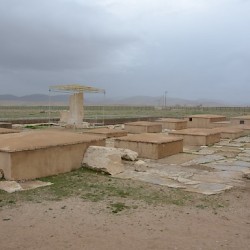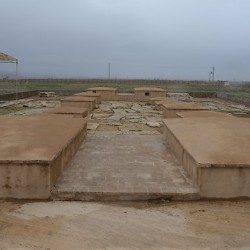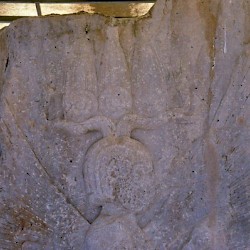Pasargadae: Gate R
Q56365260Pasargadae: one of the oldest residences of the Achaemenid kings, founded by Cyrus the Great (r.559-530).

In our sense of the word, there was no palace at Pasargadae. King Cyrus the Great (r.559-530) ordered the construction of several buildings in a park: an entrance hall ("Gate R"), an Audience Hall ("Palace S"), two pavilions (A and B), and a Residential Palace ("Palace P"). The ancient Iranian word is *paradaiza, "something surrounded by a wall", and our word "paradise" is derived from this original.

The entrance hall, called "Gate R" by the excavators, was a large building. It measures about 28½ x 25½ meters, so it must have made a considerable impact upon its visitors, often Iranian nomads who were used to living in tents. In fact, this building (like all buildings in Pasargadae) can best be seen as a very big tent made of stone. The entrance was probably guarded by apotropaic (evil-averting) statues of bulls or lamassus, and must have looked like the Gate of All Nations in Persepolis. Unfortunately, no traces of these statues are visible.
The building also contained a relief of a bearded man with four wings, dressed in an Elamite garment, wearing an Egyptian crown. Because he has four wings, he can be identified as a cherub. He is probably another apotropaic figure. One is reminded of the cherubs who, according to the Biblical book of Genesis (3.24) guarded the Garden of Eden.
Because there are many parallels for this type of apotropaic genius, the identification of this relief is not really problematic, but some confusion was caused by an inscription, known as CMc, that was once above the man's head. It was still visible in 1861 (when John Ussher made a drawing), but had disappeared fifteen years later, when K.F. Stulze visited the place.

The text of the lost inscription was as follows:
Kūruš \ xšāyathiya \ vazraka \ Kabūjiya-
hyā \ xšāyathiyahyā \ puça \ Haxāmanišiya \
thātiy \ yathā [...]
[... ...] akutā [... ]Cyrus the great king,
son of Cambyses the king, an Achaemenid,
says: When [...] made [...]
This inscription, written in the Persian ("Aryan") cuneiform script that was designed for king Darius I the Great (r.522-486), led to theory that the man on the relief represented king Cyrus himself. A drawing that was inspired by the apotropaic relief, still illustrates many websites devoted to the great conqueror.
 Pasargadae, Gate R |
 Pasargadae, Gate R |
 Pasargadae, Gate R |
 Pasargadae, Gate R, Genius |